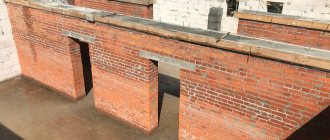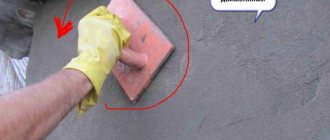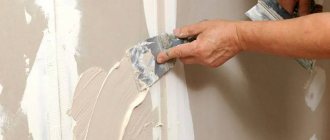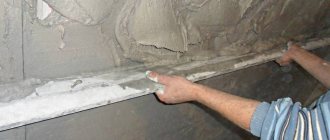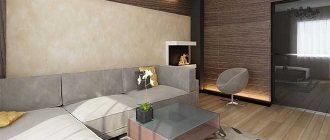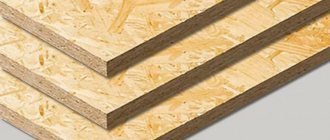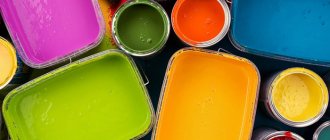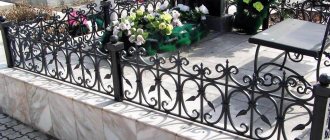Preparation
The first stage of preparing concrete structures for painting is the use of sealant.
A special composition intended for concrete is applied in one layer and dries within 24 hours. The sealant allows you to create a barrier against the penetration of mold microbes. The next stage of the work process is priming. Concrete primers have a slight tint, which is necessary to later check that the entire surface is evenly coated. If not, the primer is reapplied, drying each layer for 24 hours.
To determine whether a concrete surface is ready for painting, it is necessary to conduct a moisture test: a piece of polyethylene measuring 1 m2 is tightly glued to the concrete with adhesive tape and left overnight. If condensation has settled on the film in the morning (light “perspiration” or drops), then the concrete has not yet dried out enough and it is better to postpone finishing work for a while.
There are special impregnations for concrete that perform a dust-removing function (protecting against abrasion and crumbling), which are usually used on concrete floors.
If there are cracks
It is better to repair any surface imperfections in the form of cracks, chips, drop-shaped recesses with a special repair solution (cement, putty) using a trowel or spatula.
This will allow subsequent layers of primer and paint to lay down evenly and will extend the durability of the coating.
After using the mixture to seal cracks, it is necessary to go over the surface with sandpaper to remove excess roughness.
Without finishing
Before applying paint, the concrete surface should be washed to remove dirt and dust, which shorten the service life of any paint coating. You can clean the concrete with a soapy solution using a rag or a rough brush in case of severe contamination.
On concrete, if there is no protective coating, rust will form over time, which should also be removed before painting.
Copper sulfate solution copes well with rusty deposits.
If the affected area is too large, it is necessary to treat it with rosin varnish.
With finishing
There are three main ways to remove old finishes from a concrete surface:
- sandblasting is a hardware method that requires skill and time for subsequent drying;
- alkali solution - necessary to remove old paint;
- using a spatula is a mechanical method of scraping a layer, time-consuming, but giving an easily controlled result.
If the concrete wall is covered with dirt or soot, then the right solution would be to use a solution of soda ash to wash the contaminated surface.
Staining Concrete - Basics
Concrete will be required for construction and production of building materials. The material itself has a number of properties. Qualities:
- strength;
- resistance to mechanical damage;
- an easy way to create elements;
- durability.
When choosing what to paint concrete with, you will need to take into account all the requirements of the material for the coating. An example would be outdoor concrete paint. It must combine durability, attractiveness, as well as resistance to moisture and solar radiation.
Important! There are differences between painting concrete outdoors and indoors that will need to be taken into account when choosing a technology. This is due to the requirement to protect building materials used outdoors, since they are exposed to sunlight, precipitation, and changes in ambient temperature.
Why do this?
Painting concrete is considered a necessary activity. This procedure is carried out for reasons of aesthetics, as well as to protect the surface from negative influences. Reasons for painting a concrete surface:
- dust removal;
- obtaining protection from mechanical damage or wear;
- resistance to chemicals, temperature changes and similar factors;
- extension of service life;
- good view;
- improved performance.
Painted concrete surface will have a set of qualities depending on the type of product. Select materials that meet the necessary criteria. An example is the choice of varnish for the garage floor. It must have a good level of resistance to aggressive substances. The path in the country house or the porch of the house should be treated with varnish that is resistant to water.
The coating improves the interior and protects building materials from damage.
Interior and exterior work: differences
There are two differences between painting interior and exterior concrete.
- Surface temperature. Concrete located indoors is little susceptible to temperature changes, and when applying paint from the outside, two conditions must be strictly observed: surface temperature – above 5°C; concrete should not be overheated by direct sunlight.
- Working hours. If work inside is carried out according to the general repair schedule, then for painting external surfaces it is necessary to select a time of day when the appearance of morning or evening dew is reduced to zero.
When applying paint to exterior concrete surfaces, the weather must be suitable - cloudy but not raining.
Step by step painting instructions
The old concrete base must be dry and durable, it must be processed according to the following scheme:
- Remove all detachments, clean off mold and mildew.
- Blow off the surface with compressed air.
- Fill cracks and potholes with cement-sand mortar or repair mixtures.
- If the condition is unsatisfactory, remove old oil paint using a hair dryer or grinder.
To apply paint, you can use cotton or foam swabs. Brushes with natural bristles are suitable for acid stains and polyurethane varnishes. Synthetic brushes can be used to apply all types of water-based paints.
Painting walls inside: features
Concrete paint can be applied directly to the primer or to previously putty walls.
The choice of putty depends on the general humidity of the room: in a dry, heated place it is recommended to use gypsum solutions, in humid places - cement-based mixtures.
How to paint without putty
Painting concrete without applying a layer of plaster preserves the structure of the coating visible.
In interiors, concrete surfaces are used to emphasize the coldness and masculinity of the overall style of the room, therefore, as a rule, paint in shades of gray and sand is chosen.
Is it possible to paint without plaster?
Painting without prior puttying is possible; it is important to choose the right compositions for impregnation and primer, because they will fix the layers of paint applied to the concrete wall.
Painting in an apartment without preparation
There are modern coloring compositions that do not require the application of a base. They are not so durable, but they allow you to easily change the situation. The peculiarity of using “all-in-one” paint is the need to refill it in the sprayer.
What type of finish should be used for painting on concrete walls?
Concrete allows you to create a finishing layer of plaster, which can imitate brickwork, 3D drawings, frescoes, and partial finishing required by the interior design. In such cases, the paint is applied after the wall texture has completely dried, usually with a thin brush, for the best resemblance to the original.
How to paint without leveling
When painting walls, a problem often arises - the unevenness of the wall violates the integrity of the coating, which subsequently leads to cracking of the paint. This misunderstanding can easily be corrected by the correct selection of building materials:
- paint roller - must be marked as a tool “for uneven walls”;
- paint - you should choose a textured one that imitates waves, strokes, wood structure, etc.
How and with what to paint concrete on the street?
Timely painting of outdoor concrete will help protect the durable material from self-destruction. The concrete mixture, when hardened, has a porous structure, so prolonged exposure to a humid environment can be detrimental to reinforced concrete. Structures erected on the street react especially strongly to destructive factors. Special coloring compounds will help protect the structure from destruction, give it an aesthetic appearance and protect it from the negative influence of the environment.
- Tools and materials
- Paint: types and characteristics
- Epoxy paint
- Acrylic paint
- Polyurethane compounds
- Stages of work: how to organize painting?
- Removing contaminants
- Primer and degreaser: why are they needed?
- Staining procedure
Choosing paint indoors
The range of modern construction and finishing materials only increases with each season, so the best recommendations will be given by store consultants, taking into account the area of the room, the purpose and interior requests of the client. Paints selected for coating concrete must not only be appropriately labeled, but also contain detailed instructions for use.
Three types of paints are most commonly used.
- Epoxy. It is wear resistant. It has a rich color and protects walls from moisture. Painting work should be carried out in rooms with good ventilation. Over time, cracks may appear.
- Acrylic. It is economical in consumption; sometimes one layer is enough. Environmentally friendly. Dries quickly and is resistant to moisture. The only negative is the short service life.
- Glossy. An environmentally friendly product, but at the same time sensitive to mechanical damage.
If it is necessary to combat mold and mildew, any type of paint is suitable - the main thing is that the composition contains antibacterial components, as evidenced by special marks on the label.
Coloring compounds
For painting concrete, special composites are used, made from substances of different chemical compositions:
- oil and latex paints;
- enamels;
- varnishes;
- water-based acrylic and epoxy emulsions.
For example, one type of paint is intended only for interior coatings, another is used for exterior and interior surfaces, tolerates low temperatures and exposure to a humid environment, and is not susceptible to mechanical stress.
Therefore, when choosing a composition for treating concrete surfaces, you need to take into account its operating conditions:
- presence of aggressive media (acids, alkalis, etc.);
- concrete corrosion;
- influence of sunlight;
- mechanical loads in wet or dry climates;
- sudden change in temperature.
Staining
You can paint a concrete path in summer cottages using an inexpensive material - stain. They use water-based formulations with different types of active substances - acrylic and acid suspensions.
Acrylic stain for exterior and interior use can be used for impregnation of concrete walls and ceilings, floors, and paving slabs. When applied, the coloring polymer composite penetrates deeply into the pores of concrete without creating a film coating.
Thanks to this, materials treated with acrylic stains have the following properties:
- vapor permeability;
- durability;
- resistance to any precipitation.
After drying, the color becomes more saturated and resembles the shade of wet stone.
Kawabanga! Foundation paint for concrete: varieties, application rules
The coloring matter, interacting with calcium dioxide, creates solid colored insoluble compounds in the structure of the cement stone. The decorative properties of acid stain allow you to imitate the texture of natural stone.
Rubber paint
Rubber paint is a solution of polymer fillers and pigments in acrylic latex. The main covering component of the composition is titanium dioxide.
After this substance dries, a durable elastic film is created on the surface of the concrete, protecting the base from the formation of cracks, fungi and mold. The coating has a matte tint, is non-toxic, washes well and has a long service life.
Epoxy and acrylic paints
- moisture resistance;
- possibility of applying layers of paint on surfaces with humidity up to 15%;
- high mechanical strength;
- abrasion resistance;
- high adhesion;
- does not contain organic solvents.
Polyurethane varnishes
Composites are divided into two- and one-component. One-component compositions set due to the humidity present in the atmospheric environment. They do not require a hardening accelerator.
Pro Tips:
- Painting work must be carried out wearing safety glasses. When using strong-smelling paint, wear a respirator.
- Before applying paint, you need to prepare your tools: fluff the brushes and check if they are losing bristles; Soak the roller under a strong stream of water, then wring it out and smooth out the pile.
- To protect the floor and ceiling at the joints with the wall, use masking tape, which is peeled off after painting. If necessary, individual areas are then worked on with a thin brush.
- When applying paint, it is important to remember that each layer should be as thin as possible. A wall painted in three thin layers looks better than one too thick, which creates streaks.
- As a rule, concrete walls are puttied in two layers: the first is gypsum or cement plaster, then the finishing putty. This method allows you to achieve a perfectly even coating.
Painting concrete surfaces with paint is not difficult for either beginners or experienced finishers. When painting, it is important to wait patiently until each layer of coating dries, then the result will be uniform and durable.
Concrete paint manufacturers
The main difference between paints is their chemical composition. All the characteristics of the paint coating depend on it. Nowadays there is a huge selection of paints of all colors and textures on sale.
Mizar Rezolux Profi-52
This enamel is intended for painting concrete floors and stairs. It is characterized by increased frost resistance - the minimum permissible operating temperature reaches -15°C. While similar products (which include, for example, the popular Tikkurila Betolux Aqua) are not recommended for use at temperatures below +5°C.
Mizar Rezolux Profi-52 is suitable for painting concrete surfaces inside residential and non-residential premises (warehouses and garages), as well as interfloor and street stairs. For example, one of the largest housing developers in Russia uses Rezolux Profi-52 to paint public areas and staircases.
Enamel can be used not only for painting concrete, but also furniture, doors, wallpaper for painting and other surfaces. It has excellent wear-resistant, water-repellent and strength properties. The cost of 1 kg of “Mitsar” Rezolux Profi-52 is 220 rubles. And this is four times cheaper compared to the popular Tikkurila Betolux Aqua enamel.
The St. Petersburg manufacturer - the Mizar company - is notable for its vast experience in the development and production of coatings with increased wear and weather resistance (exposure to high/low temperatures, precipitation, etc.).
For example, Mitsar enamels with anti-corrosion and acid-resistant properties were used in the construction of the Leningrad and Kola nuclear power plants. Also, the manufacturer’s materials have the lowest (up to 5 times!) price among competitors with the same or higher parameters.
Therefore, paint and varnish materials of the Mizar company regularly win tenders and are actively supplied to enterprises within the framework of the State Defense Order.
Painting concrete facades
To successfully paint a concrete facade, it must be properly prepared, the most suitable one must be selected, and the time required for drying must be maintained.
- Clean the concrete from old paint, dirt, and plaque. If there is mold, moss, or fungi on the surface, they must be removed.
- Seal all cracks, holes, and uneven areas, as moisture can accumulate there under the paint layer, which as a result will begin to peel off and move away from the concrete. The surface should be as smooth and even as possible.
- Begin work when weather conditions are favorable. It's best to have 2-3 days in a row without rain before you start painting.
- To ensure a high-quality coating, it is recommended to apply a layer of primer. This is especially true if the paint is applied over an old layer that is different in color from the new one.
- In the process of painting the facade, scaffolding or ladders, rollers, gloves, and buckets will be useful. It is better to prepare these materials in advance so that everything is at hand during work.
- Calculate the area that needs to be painted. Then multiply the resulting number by the average consumption of facade paint (it is indicated on the labels). And multiply the resulting figure by two. Typically several coats are required.
After preparing the concrete, you can begin painting. You should start from a corner or from the top if you are painting a wall. The color is distributed slowly and evenly over the entire surface. Each subsequent layer is applied after the previous one has dried.
It is not recommended to paint freshly plastered facades, as the plaster must “ripen”, usually this happens no earlier than after 28 days. Exterior paints are the best way to improve the appearance of your home and give it a finished, beautiful look.
Features of concrete pavement
Concrete is often chosen as the main surface during exterior or interior renovations. The choice is explained by the ease of working with the materials and the properties of its operation. For exterior finishing, the material is selected based on its main positive aspects:
- Easy to care for. This includes the convenience of pouring the solution; with proper preparation, it is evenly distributed over the surface;
- Low price. Compared to other similar materials, concrete finishing is cheap;
- High wear resistance and strength. The result can withstand high loads, unlike other base materials;
- Resistance to aggressive external factors;
- Practicality, versatility. Regardless of coatings or paints applied to the surface, the coating remains in the same condition.
The frost-resistant surface is standardly used for laying external structures. This property explains the importance of choosing a dye for application to the wall. Otherwise, there is a risk of cracks forming in the decorative coating or other defects in the result. However, keep in mind that the main disadvantage of concrete is the rapid accumulation of dust on the surface. This can be prevented by laying floors - laminate or linoleum. However, paint will solve this problem faster because it completely covers the entire layer, creating a glossy finish.
Concrete
